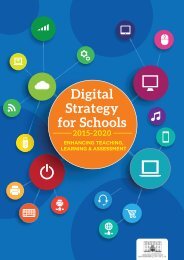K3zgZ
K3zgZ
K3zgZ
Create successful ePaper yourself
Turn your PDF publications into a flip-book with our unique Google optimized e-Paper software.
TRADOC Pam 525-8-2<br />
Table D-7<br />
Instructor student ratio examples<br />
Type of Instruction ISR Comments<br />
Audience 1: audience Size does not matter. Passive,<br />
one-way presentation.<br />
Conference and discussion 1: 25<br />
Large group instruction 1: 25<br />
Small group instruction 1: 16<br />
Facilitated problem centered<br />
instruction<br />
1: 8 (recommended) Groups work on their own<br />
with faculty and/or instructor<br />
support. Possible to work<br />
with multiple groups.<br />
Note: ISRs are lower after using Manpower Staffing Standards System calculations to compensate for<br />
other types of instructor work hours, such as time required for development, preparation, student<br />
assessment, grading, counseling, profession development, and publishing (for military education<br />
institutions).<br />
D-10. Faculty and instructor selection and development<br />
a. ARFORGEN has a significant impact on faculty and instructor selection and availability.<br />
Yet, the importance of faculty and instructors within the institutions requires noting. They are<br />
the key to quality training and education. “The success of institutional education and training<br />
depends on having experienced faculty who are leadership mentors, role models, and teachers.” 49<br />
b. Challenges within PME today have produced a mixed quality of faculty and instructors.<br />
The demands of war provide limited assignments or availability periods for the best military<br />
faculty and instructors. Rewards have been limited although command and promotion rates for<br />
military officer faculty continue in a favorable trend. A recruitment and retention issue for<br />
civilian academic scholars in Army colleges is largely due to limited opportunities for scholarly<br />
advancement (through workload and copyright restrictions) and term-limited appointments.<br />
D-11. Distributed learning<br />
a. dL leverages the power of information and communication technologies (such as,<br />
simulation, interactive media instruction, video teletraining, e-learning, and others) to deliver<br />
standardized training and education at the right place and time. dL may involve studentinstructor<br />
interaction in real time (synchronous) and non-real time (asynchronous). It may also<br />
involve self-paced student instruction without benefit of an instructor. Efficient use of resources<br />
and return on investment for content identified as appropriate for basic dL (stable, high volume)<br />
is one of the primary purposes of dL, while other high-end technology applications provide<br />
returns in quality of learning based on fidelity, immersion, and motivation, among other aspects<br />
appealing to learners. The primary importance to learners, however, is improved access and<br />
opportunity and increased lifelong learning to benefit career development.<br />
b. Challenges and problems with dL quality, development, and maintenance within the Army<br />
have caused many negative perceptions to persist, while at the same time, enrollment in online<br />
civilian universities has increased greatly. Development of Army dL has been plagued by<br />
51




